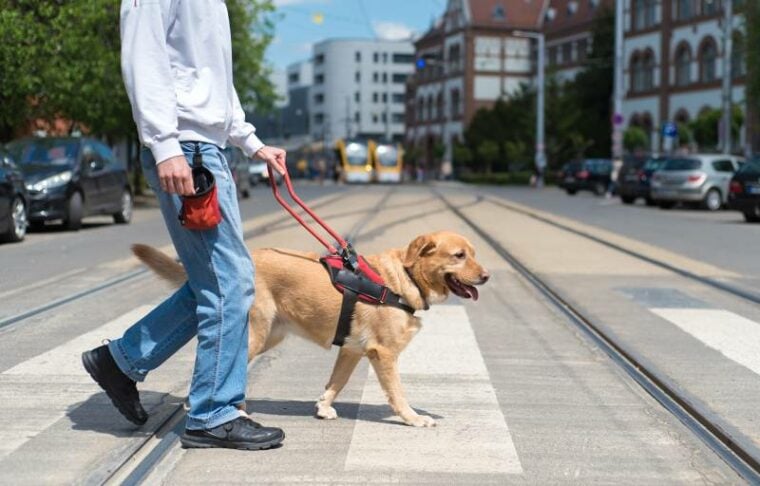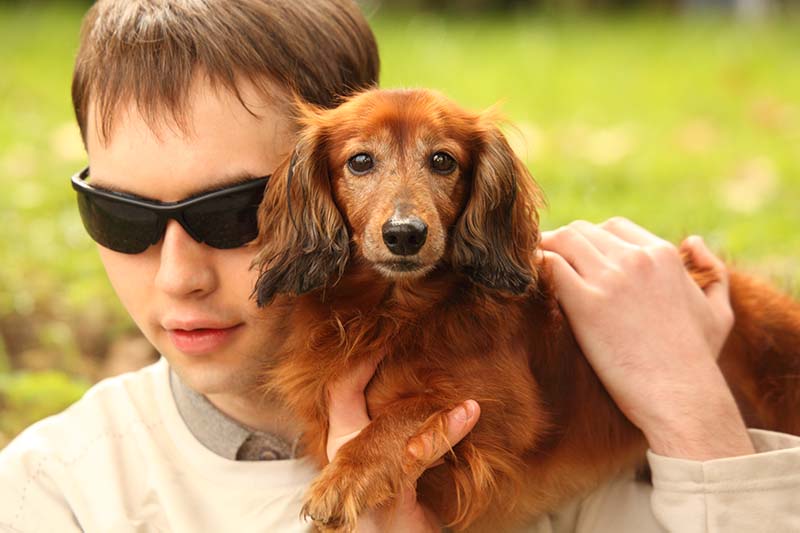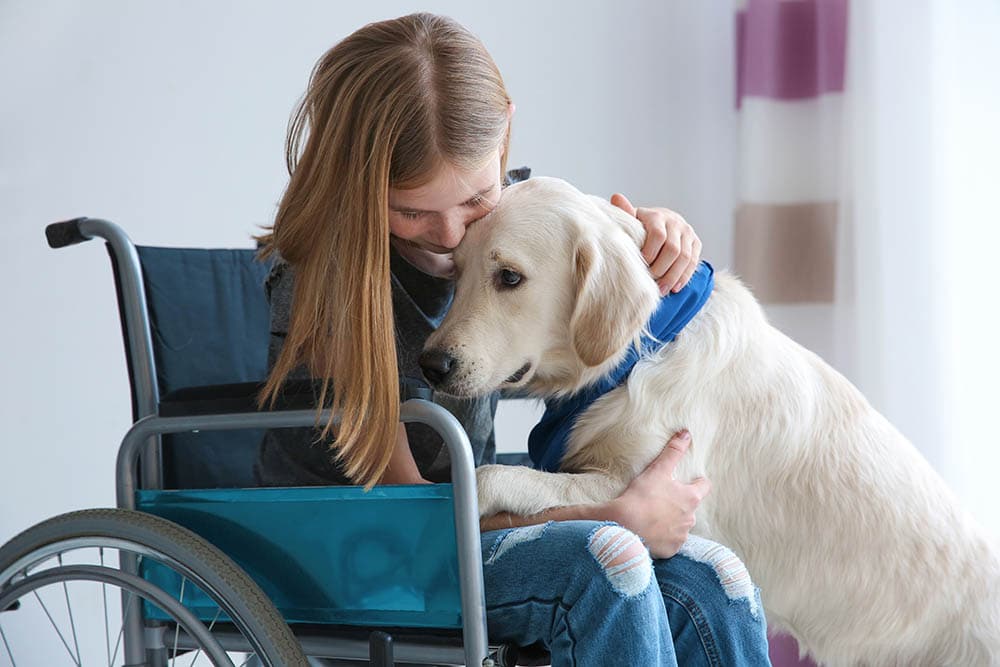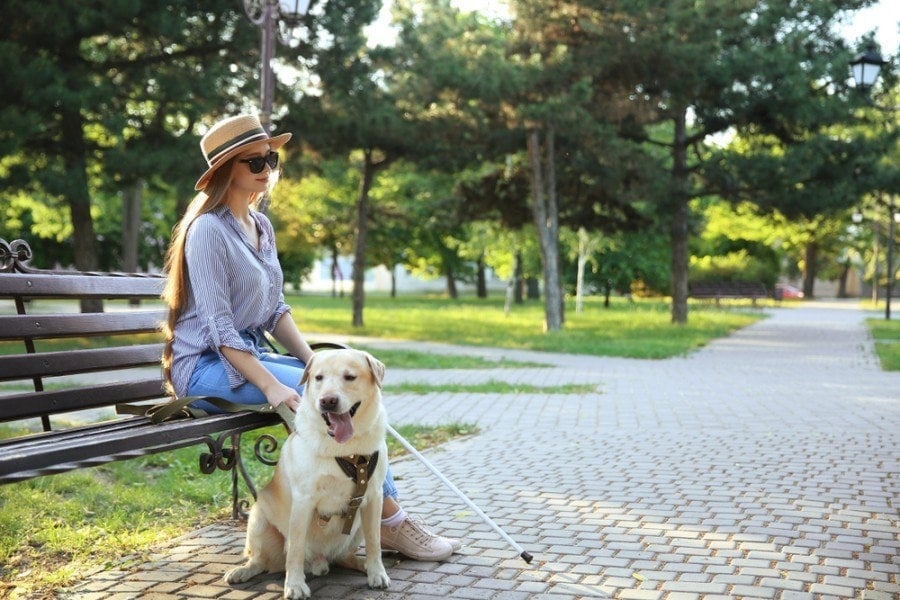
Click to Skip Ahead
Dogs are remarkable beings with many qualities they bring to the table. Dogs have the intelligence to be trained as guide dogs, which is an invaluable asset to people with vision and hearing issues. Guide dogs are trained in various facets to help people with limitations or physical disabilities live a life without boundaries. Guide dogs can enrich these individuals’ lives, allowing them to gain independence and mobility in their day-to-day lives. A guide dog is trained through a structured process that involves teaching them to assist individuals with visual impairments by learning various commands, navigation skills, and safe behaviors.
In this guide, we’ll explore how guide dogs are trained as well as the different types of guide dogs available, and more.
How Does Guide Dog Training Work?
Guide dogs undergo rigorous training and are appropriately paired with an individual for the best outcome. People in need of a guide dog can apply through a non-profit organization, such as Guide Dogs of America, to be matched with the best canine for the job for that particular person.
Many factors go into account before pairing a guide dog with an individual. For instance, the person’s living arrangements, activity level, hobbies, family, and other pets must be determined in order to pair the person with the appropriate guide dog. For a successful pairing, the guide dog needs to be happy and bond with the owner.

When Does Training Begin for Guide Dogs?
Guide dog training and socializing begin when the dogs are young pups and continue throughout their lives, with many different people involved in the training process. In fact, some organizations have their own breeding programs for this purpose. Puppies born into these organizations will typically start training at roughly 8 weeks of age by puppy raisers, whose main job is to begin socializing the puppies and teaching essential obedience.
When the dogs reach 12–18 months old, they are returned to the organization to start a formal guide dog training program with professional handlers. The training will last for months before being paired with a blind or deaf handler.
What Characteristics Does a Handler Need for Success?
When someone applies for a guide dog, the organization will look at certain characteristics the handler has in order to successfully pair a dog with that individual. For example, someone applying for a guide dog due to vision loss must be declared legally blind, and a person with hearing issues must be deaf or hard of hearing. Applicants must be physically able to take care of the dog’s needs (feeding, grooming, yearly checkups, food, toys, etc.).

What Exactly Are Guide Dogs Trained to Do?
Much to the contrary, some people mistakenly believe that guide dogs are a live-in GPS. In other words, guide dogs do not possess the ability to read traffic signals, walking signals, or road signs. So, how do they know to guide their handler? Guide dogs are trained to take directional cues from their handler; they are also taught to respectfully and intelligently disobey when a dangerous obstacle is in the handler’s path. These dogs are trained to look out for unsafe objects and situations that a blind person cannot detect, even an overhead obstruction. The dog must also be “intelligently obedient,” meaning the dog is obedient but will disobey an unsafe cue from the handler.
The handler must listen for the flow of traffic and will give the guide dog the command to proceed. However, this is when training comes to full use—the guide dog must make the decision if the area is truly safe to cross, and the handler must trust the dog’s judgment.
During the training process, guide dogs are trained not to be distracted by loud noises, children, other animals, or any other possible distraction while with their handler, which takes obedience, intelligence, and extensive training on the dog’s part. This is why it’s extremely important not to walk up to and pet a guide dog on duty so you don’t distract him for safety purposes. Guide dogs must be friendly, but they must also have the intelligence and obedience not to be distracted by certain noises, other people, small animals, and so on.
What Are the Different Types of Guide Dogs?
As we’ve mentioned, guide dogs must have the intelligence to be successfully trained as a guide dog. For this reason, typically Labrador Retrievers, Golden Retrievers, Standard Poodles, Border Collies, Australian Shepherds, and Doberman Pinschers are used as guide dogs.

Where Are Guide Dogs Used?
Guide dogs can be used in schools, homes, work, restaurants, hotels, or any other place the handler needs to go. Guide dogs are considered service dogs, meaning they can go anywhere with their handler, even if no dogs are allowed in a particular facility, including airplanes.
Guide dogs are not just for the blind or visually impaired; they are also beneficial to deaf or hard-of-hearing people. Guide dogs trained for the deaf and hard of hearing are trained to alert the handler to important noises, such as a doorbell, fire alarm, alarm clock, or any other important sound. Having a guide dog for these purposes allows someone with hearing problems to live a more independent life safely while living alone.
Advantages of Having a Guide Dog
Guide dogs can drastically improve a person’s life with vision or hearing disabilities. Guide dogs allow people with these disabilities to live independent lives and help them gain mobility. Guide dogs also provide an everlasting bond and friendship with their handler, which can also improve one’s mental status when faced with seemingly impossible odds.
Guide dogs can help ease depression, anxiety, and stress for their handler; they also help their handler improve their cardiovascular health by taking walks, which would be almost impossible for a blind person without their guide dog and companion.

Disadvantages of Having a Guide Dog
As wonderful as guide dogs are, disadvantages do exist. Sadly, a guide dog does not live forever and will eventually pass away—dogs simply do not live as long as we’d like, and guide dogs are no exception.
A guide dog may develop an illness and be forced to retire, at which point the handler will need to acquire another guide dog, which can be costly, not to mention, the emotional aspect of losing a dog and best friend.
Lastly, dogs are a lot of work, and guide dogs are no exception. You must be able to clean up your dog’s mess, find a suitable place for him to go potty if out in public, and so on. You must also take care of your dog, as he’ll have needs too, such as being fed, getting ready for travel (especially on an airplane), and so on. However, one must be a dog lover, to begin with, before contemplating getting a guide dog.
Frequently Asked Questions (FAQs)
How Much Does It Cost to Acquire and Own a Guide Dog?
Unfortunately, obtaining a guide dog can be costly; you can expect to pay anywhere from $26,000 to $60,000 depending on your location and the organization to obtain the dog from. However, some non-profit organizations operate strictly on donations and fundraising to help pay for training and other expenses, which allows the organization to lower the price of the dog, if not provide the dog for free.
Your guide dog will also have monthly expenses, such as food, heartgard medication, grooming items, veterinary care, and more, and you must have the financial means to care for the dog properly.

What Is the Average Working Life of a Guide Dog?
Guide dogs typically can work anywhere from 6 to 10 years, granted they stay healthy in all the years in between. After that period, they will need to retire and become a pet.
Can I Keep My Guide Dog as a Pet After Retirement?
Of course! In fact, keeping your guide dog after retirement is ideal for both the handler and the dog, as a special bond will be formed between the two. Even if you acquire another guide dog, you can still keep your former guide dog as long as you have the means to take care of him properly.
Conclusion
Guide dogs help the visually or hearing-impaired lead an independent and social life. The bond between handler and dog is something most people will never have with their own pets, regardless of how much of a bond you have. Guide dogs are a handler’s eyes and ears, and the handler depends on them for their safety. However, guide dogs are still dogs and require love and attention, and one must be willing to take on the responsibility of adding a guide dog into their life.
Guide dogs are invaluable to a person with these disabilities, as these dogs help them live a life full of mobility and independence, and the handler gains a best friend for life.
Featured Image Credit: SasaStock, Shutterstock






